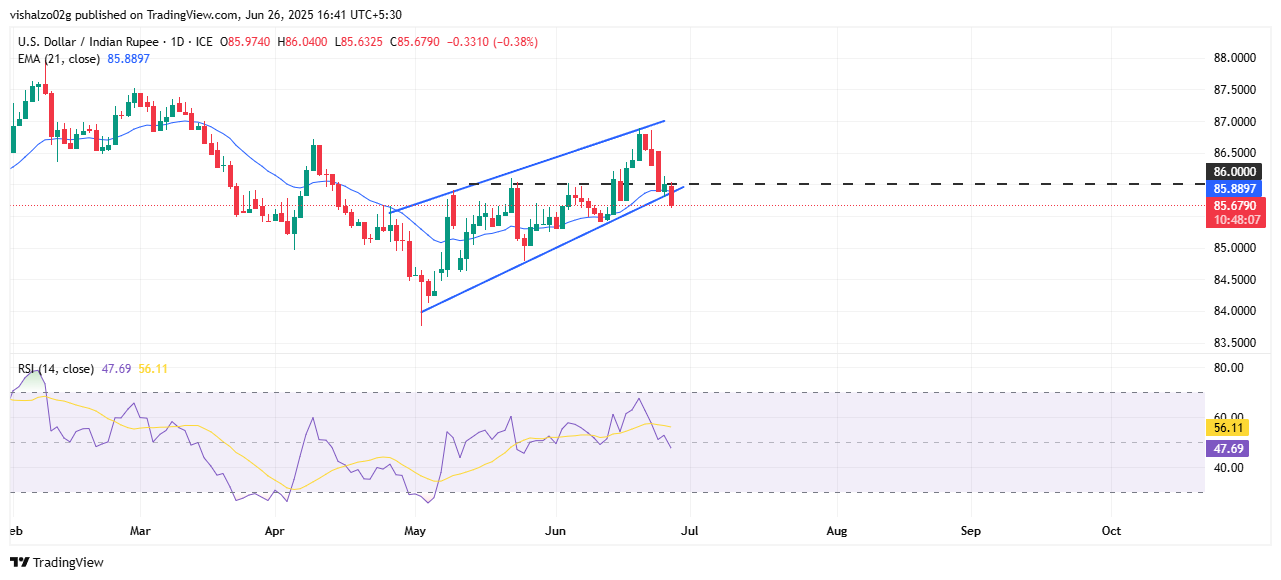- Indian rupee is strengthened while the American dollar index falls per fourth consecutive session, reaching a new minimum of three years.
- The US president Trump renews attacks on the president of the Fed Powell, calls him “terrible” and points out plans to appoint a replacement.
- Moderate crude oil prices and the decrease in geopolitical tensions support the recovery of rupee from a minimum of three months.
The Indian rupee (INR) is stronger in front of the US dollar (USD) on Thursday, driven by a strong drop in the US dollar index (DXY), which collapsed to a new minimum of three years. The dollar fell under renewed pressure in the midst of growing concerns about the independence of the Federal Reserve (Fed), after the critical comments of the US president Donald Trump. Increasing the downward pressure were the decrease in geopolitical tensions and moderate crude oil prices, both factors that helped improve the feeling of risk and support currencies of emerging markets, such as rupee.
The sales interest resurfaces in the USD/INR, with the par quoting about 85.70 during the European negotiation hours after a modest rebound the previous day. The torque has dropped approximately 0.35% and has fallen below the exponential (EMA) mobile average of 21 days, which suggests a bearish perspective In the future.
Meanwhile, the US dollar index (DXY), which tracks the dollar against a basket of six main currencies, remains under pressure, marking its fourth consecutive daily loss. The index is currently about 97.20, its lowest level since February 2022.
The main factor that drives the profits of the rupee today is the strong weakening of the US dollar after the renewed criticism of the president of the Fed Jerome Powell by the US president Donald Trump. Speaking at a press conference after the NATO summit in The Hague, Trump called Powell “terrible”, accused him of being “very political” and reiterated his call to cuts in interest rates. Trump also confirmed that he is considering “three or four” possible replacements for Powell, whose mandate ends in May 2026. Comments have amplified concerns about political interference in the US monetary policy, undermining the confidence of investors in the independence of the Fed and weighing strongly over the dollar.
What moves the market today: the rupee advances in the face of the uncertainty of the Fed, the fall of oil and the increase in shares
- The Indian rupee, which had been under pressure during the Iran-Israel conflict and fell to a minimum of three months of 86.89 last week, is experiencing a strong recovery after high fire, recovering levels seen before climbing in the middle of the decrease in geopolitical tensions.
- Moderate crude oil prices are offering relief to Indian rupee, with the WTI quoting about $ 64.70 and the Brent around $ 66.80 – both lowering approximately 12% so far this week. The strong correction, driven by the high Iran-Israel fire and the decrease in concerns about the offer, has improved the import perspectives of India and reduced external pressure on the currency.
- In the Front of Actions, the Sensex shot more than 1,000 points to close at 83,755, while the NIFTY jumped 304 points to finish at 25,549 – both winning 1.21%. The strong rebound increased the confidence of investors, with market capitalization in the BSE increasing in ₹ 3.33 Lakh crore to ₹ 457.33 Lakh Crore, further supporting the feeling around the rupee.
- Although the rupee has recently gained ground against a weakest US dollar, it remains one of the worst performance coins in Asia this year. A mixture of winds against global – including global tariff tensions and geopolitical uncertainty – along with internal challenges such as the persistent FII departure, a negative international investment position (NIIP) and a increasing commercial deficit, continues to weigh on the currency.
- On the US side, the repeated criticisms of President Donald Trump to the Fed continue to shake the markets. His main complaint is that interest rates remain too high, which, according to him, is hindering growth and increasing government debt costs. Trump has argued that, with inflation under control, rates should be 2 to 3 lower percentage points, citing movements from the European Central Bank and warning that delays could stagnate the US economy.
- US president Donald Trump reaffirmed his position during recent statements, stating, “We have no inflation. We have a tremendous economy. Hundreds of billions of dollars in tariff money are flowing. Factories are being built.” He also said that almost 15 billion dollars in investment were flowing towards the US while pressing for aggressive features of fees, Trump acknowledged that if inflation increased significantly, would support future rates of rates.
- According to the Wall Street Journal, President Trump is considering announcing his favorite election for president of the Federal Reserve as soon as in September or October. The reported contestants include former Fed Kevin Warsh, the director of the NEC Kevin Hasset, the current governor of the Fed Christopher Waller and Treasury Secretary Scott Besent.
- In a recent testimony before Congress, the president of the Fed, Jerome Powell, defended the caution approach of the Central Bank’s policy in the midst of a growing political scrutiny. Although he acknowledged that recent inflation data has been moderated, Powell warned that Trump tariffs could add upward pressure on prices in the coming months. He reaffirmed that Fed’s actions will continue to depend on the data and aligned with their dual stable pricing mandate and maximum employment, instead of being influenced by politics. “We always do what we believe is the right thing, and we live with the consequences,” Powell said, underlining the Fed’s commitment to institutional independence.
- Personal consumption expenditure (PCE) rises to 3.5%. The data published today revealed that the Fed preferred inflation indicator rose more than expected in May, reaching 3.5% year -on -year from 3.4% in April, complicating the path of the Fed policy amid the political pressure for rate cuts.
- The US economy contracted an annualized rate of 0.5% in the first quarter of 2025, marking a deeper fall than the 0.2% decrease estimated above. This is the first quarterly contraction in three years, reflecting a weakening of consumer spending and business investment amid high interests of interest and global uncertainty.
- Initial unemployment requests in the US fell to 236,000, exceeding the consensus of 245,000 and pointing to the resilience of the labor market despite broader signs of cooling.
Technical analysis: the USD/INR breaks the ascending wedge, the bias becomes bassist

The rupture in the USD/INR pair marks a notable change in the perspective after weeks of ordered profits within an ascending wedge formation. The inability of the torque to stay above the 21 -day EMA, along with a clear rupture of the wedge pattern support, has triggered technical sales. Currently around 85.67, the torque seems vulnerable since the old level of support about 86.00 has now become resistance, limiting upward attempts. This rupture follows a typical reversion pattern that often precedes deeper setbacks.
The Relative Force Index (RSI) has fallen abruptly from near the territory of overcompra and is currently in 47.69, below the 50’s neutral brand, indicating a fading of the bullish momentum. If the torque fails to recover the area of 86.00–85.90, the next support level is about 85.00, followed by the 84.40 region, which is aligned with the previous oscillation minimums of the beginning of June. On the positive side, only a decisive daily closure above 86.00-86.20 would deny the current bearish structure and reopen the path to the levels of 86.90–87.00. For now, bias remains bassist since the PAR confirms a technical breakdown of a key wedge pattern.
Source: Fx Street
I am Joshua Winder, a senior-level journalist and editor at World Stock Market. I specialize in covering news related to the stock market and economic trends. With more than 8 years of experience in this field, I have become an expert in financial reporting.







